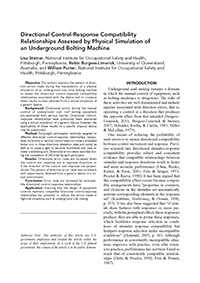Mining Publication: Directional Control-Response Compatibility Relationships Assessed by Physical Simulation of an Underground Bolting Machine
Original creation date: March 2014
The authors examine the pattern of direction errors made during the manipulation of a physical simulation of an underground coal mine bolting machine to assess the directional control-response compatibility relationships associated with the device and to compare these results to data obtained from a virtual simulation of a generic device. Directional errors during the manual control of underground coal roof bolting equipment are associated with serious injuries. Directional control-response relationships have previously been examined using a virtual simulation of a generic device; however, the applicability of these results to a specific physical device may be questioned.
In this study, forty-eight participants randomly assigned to different directional control-response relationships manipulated horizontal or vertical control levers to move a simulated bolter arm in three directions (elevation, slew, and sump) as well as to cause a light to become illuminated and raise or lower a stabilizing jack. Directional errors were recorded during the completion of 240 trials by each participant. Directional error rates increased when the control and response were in opposite directions or if the direction of the control and response were perpendicular. The pattern of direction error rates was consistent with experiments obtained from a generic device in a virtual environment. The authors conclude that error rates are increased by incompatible directional control-response relationships. Ensuring that the design of equipment controls maintains compatible directional control-response relationships has potential to reduce the errors made in high-risk situations, such as underground coal mining.
Authors: LJ Steiner, R Burgess-Limerick, WL Porter
Peer Reviewed Journal Article - March 2014
NIOSHTIC2 Number: 20043705
Hum Factors 2014 Mar; 56(2):384-391
See Also
- A Case Study of Roof Bolting Tasks to Identify Cumulative Trauma Exposure
- Inexpensive, Easy to Construct Materials-handling Devices for Underground Mines
- Job Design: An Effective Strategy for Reducing Back Injuries
- Job Training Analysis: A Process for Quickly Developing a Roadmap for Teaching and Evaluating Job Skills
- Laboratory Investigation of Seat Suspension Design Performance during Vibration Testing
- Repeatability of a Checklist for Evaluation Cab Design Characteristics of Heavy Mobile Equipment
- Roof Screening: Best Practices and Roof Bolting Machines
- Self-Reported Musculoskeletal Symptoms Among Operators of Heavy Construction Equipment
- Task Analysis
- Toward a Typology of Dynamic and Hazardous Work Environments
- Content source: National Institute for Occupational Safety and Health, Mining Program


 ShareCompartir
ShareCompartir
